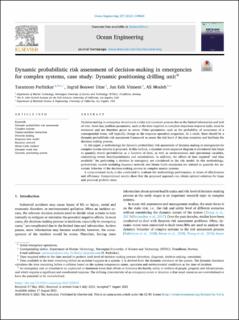| dc.contributor.author | Parhizkar, Tarannom | |
| dc.contributor.author | Utne, Ingrid Bouwer | |
| dc.contributor.author | Vinnem, Jan Erik | |
| dc.contributor.author | Mosleh, Ali | |
| dc.date.accessioned | 2022-09-08T12:28:53Z | |
| dc.date.available | 2022-09-08T12:28:53Z | |
| dc.date.created | 2022-01-10T14:45:29Z | |
| dc.date.issued | 2021 | |
| dc.identifier.citation | Ocean Engineering. 2021, 237 . | en_US |
| dc.identifier.issn | 0029-8018 | |
| dc.identifier.uri | https://hdl.handle.net/11250/3016631 | |
| dc.description.abstract | Decision-making in emergency situations is a risky and uncertain process due to the limited information and lack of time. Some key problem parameters, such as the time required to complete important response tasks, must be estimated and are therefore prone to errors. Other parameters, such as the probability of occurrence of a consequential event, will typically change as the response operation progresses. As a result, there should be a dynamic probabilistic risk assessment framework to assess the risk level of decision scenarios and facilitate the decision-making process.
In this paper, a methodology for dynamic probabilistic risk assessment of decision making in emergencies for complex marine systems is proposed. In this method, a dynamic event sequence diagram is introduced that helps to quantify events probabilities as a function of time, as well as environmental and operational variables, considering events interdependencies and uncertainties. In addition, the effects of time required1 and time available2 for performing a decision in emergency are considered in the risk model. In this methodology, probabilistic models including Bayesian network and Monte Carlo simulation are utilized to quantify the uncertain behavior of the decision-making process in complex marine systems.
A computational study is also conducted to evaluate the methodology performance, in terms of effectiveness and efficiency. Computational results show that the proposed approach can obtain optimal solutions for large and practical problem sizes. | en_US |
| dc.language.iso | eng | en_US |
| dc.publisher | Elsevier | en_US |
| dc.rights | Navngivelse 4.0 Internasjonal | * |
| dc.rights.uri | http://creativecommons.org/licenses/by/4.0/deed.no | * |
| dc.title | Dynamic probabilistic risk assessment of decision-making in emergencies for complex systems, case study: Dynamic positioning drilling unit | en_US |
| dc.type | Peer reviewed | en_US |
| dc.type | Journal article | en_US |
| dc.description.version | publishedVersion | en_US |
| dc.source.pagenumber | 21 | en_US |
| dc.source.volume | 237 | en_US |
| dc.source.journal | Ocean Engineering | en_US |
| dc.identifier.doi | 10.1016/j.oceaneng.2021.109653 | |
| dc.identifier.cristin | 1977674 | |
| cristin.ispublished | true | |
| cristin.fulltext | postprint | |
| cristin.qualitycode | 1 | |

